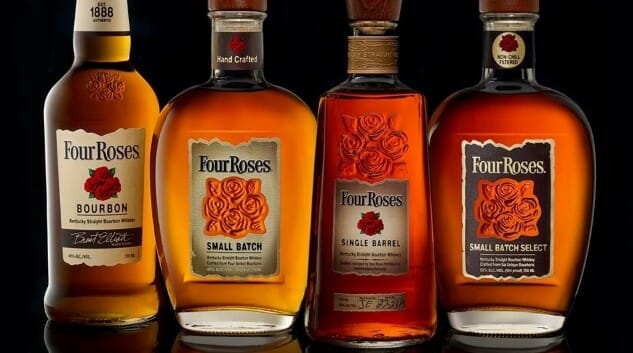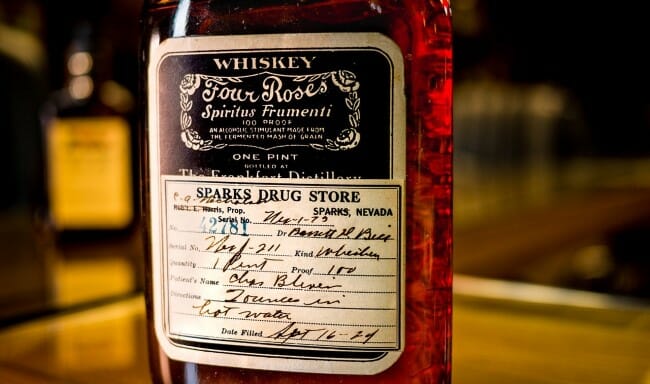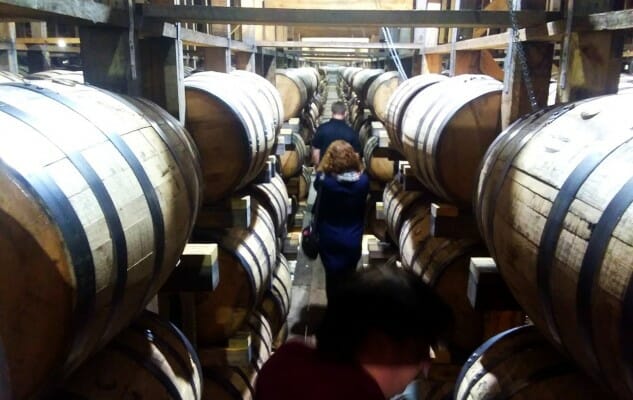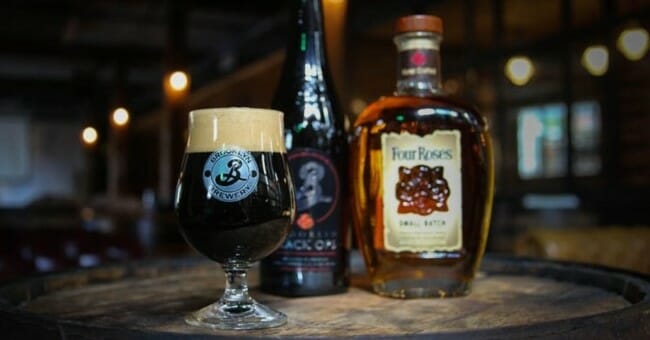The Remarkable Resurrection and Unique Nature of Four Roses Bourbon
Photos by Jim Vorel and courtesy Four Roses Drink Features whiskey
As recently as 2002, you couldn’t buy a bottle of Four Roses Bourbon in the U.S.A.
That’s an odd factoid, certainly, for a classic Kentucky distillery that proudly cites the year 1888 as its origin point, and a brand that has been deeply associated with American whiskey for more than 130 years. And yet, it’s entirely accurate—Four Roses Bourbon didn’t exist in the U.S. at the turn of the 2000s, and in fact hadn’t existed for almost 50 years at that point. Despite the fact that Four Roses is now available nationwide, it was only 17 years ago that it returned to the U.S. after its half-century hiatus. And since that time, the company has completed a meteoric rise to reclaim a place of post-Prohibition prominence that most would have likely thought impossible, increasing its production of both affordable, 80-proof flagship bourbon and sought-after limited editions while winning the adulation of whiskey geeks around the world.
The Four Roses story, in fact, proves to be an oddly unique tale at every turn. Attending a recent press trip to the distillery, I was frankly shocked by how much I didn’t know about a brand I’d regularly consumed for years.
Mythic Beginnings
Unlike many of the classic Kentucky distilleries, the origin story of Four Roses isn’t well established in the historical record, and largely comes down to apocrypha. Some histories point to American businessman Rufus M. Rose as the original founder, but the company itself (and Japanese parent company Kirin) considers Paul Jones Jr. the founding father of the company—according to their research, Jones Jr. trademarked the name “Four Roses” in 1888 (the year cited on every bottle) and claimed that the spirit had been produced and sold as far back as the 1860s, although it’s not clear where this would have happened. What is known is that the now-iconic Four Roses distillery in Lawrenceburg, KY, with its unusual, Spanish Mission-style architecture, was built in 1910, giving the company a true anchor for its operations. And as for the name? Well, we have this dubiously romantic tale:
It began when Paul Jones, Jr., the founder of Four Roses Bourbon, became smitten by the beauty of a Southern belle. It is said that he sent a proposal to her, and she replied that if her answer were “Yes,” she would wear a corsage of roses on her gown to the upcoming grand ball. Paul Jones waited for her answer excitedly on that night of the grand ball … when she arrived in her beautiful gown, she wore a corsage of four red roses. He later named his Bourbon “Four Roses” as a symbol of his devout passion for the lovely belle, a passion he thereafter transferred to making his beloved Four Roses Bourbon.
Today, that likely story is treated with a certain mythological detachment by the folks at Four Roses—a willingness to humor a romantic origin, while focusing the lion’s share of their attention on the liquid in the bottle. And really, it’s not the origin of Four Roses that is the most interesting thing about its history—it’s the way the brand disappeared from the U.S. for half a century before coming roaring back.
Prohibition, Japan, and the “Imposter” Four Roses
When Prohibition descended on the U.S. in 1919—I’ve written several detailed pieces on this very topic in 2019—Four Roses found itself in a rather fortunate position. Unlike many distilleries that were shuttered outright, or sold their stores to Canadian distilleries (which sold that booze right back to us in the form of bootleg hooch, naturally), Four Roses persisted as one of only six American distilleries that retained the right to legally operate during Prohibition, making whiskey for “medicinal” purposes. That particular loophole, in addition to enriching doctors and pharmacists prescribing booze (the modern American pharmacy boomed during Prohibition, for obvious reasons), meant Four Roses was well positioned to dominate the post-Prohibition whiskey market, having a head start over almost all competition when Repeal came along in 1933. And so they did, reigning as the #1 American bourbon for several decades in the 1930s and 1940s.
 A vintage, Prohibition-era “medicinal” bottle of Four Roses.
A vintage, Prohibition-era “medicinal” bottle of Four Roses.
By the 1950s, however, times and consumer preferences had clearly begun to change. Clear liquors such as vodka, gin and tequila were surging in the U.S., and brown liquor producers were feeling the pinch. Existing American whiskeys were increasingly produced with lighter flavor profiles, and many gave way to lighter Canadian imports, such as the ubiquitous Canadian Club, today owned by Beam Suntory. Four Roses, meanwhile, had been acquired by Canadian liquor giant Seagram in 1943, which eventually led to a rather shocking decision: the complete removal of Four Roses Bourbon from the American market in the mid 1950s. After dominating the sphere for decades, the country’s most famous bourbon instead went abroad, funneled into the growing market for bourbon in Europe and Asia. In particular, Four Roses became massively popular in Japan, where it rapidly became the country’s most ubiquitous bourbon brand. Today, separate Japanese brands of Four Roses (“Black Label” and “Super Premium”) still exist specifically for that major market, and are sought after by American collectors.
What about the U.S., though? What of your father or grandfather, who insists he was a regular consumer of Four Roses during the 1960s or 1970s? As it turns out, he’s not mistaken—he just wasn’t drinking bourbon.
Rather, from the late 1950s to the early 2000s, what was found in American bottles of “Four Roses” was simply cheaper Canadian blended whiskey. These lighter spirits, containing substantial portions of double-distilled “light whiskey,” did not meet the federal definition for “bourbon,” which requires among other things the aging of spirits in newly charred oak. It’s not that the Canadian-made version of Four Roses was objectively bad—although the brand’s reputation did suffer, over the years—but it simply wasn’t bourbon. And ironically, the production of real bourbon at the Lawrenceburg facility had never stopped—it just was unattainable for U.S. customers. Even those working at the distillery couldn’t snag a bottle of actual bourbon for themselves before it was shipped off to Europe or Asia.
The Brown Liquor Revival
In 2002, Four Roses was acquired by the Kirin Co. of Japan, the beverage giant recently in U.S. news once again for their acquisition of historic craft brewery New Belgium Brewing Co., in addition to a 24.5% stake in New York’s Brooklyn Brewery. And as an element of the acquisition, Four Roses management requested a boon: They wanted to bring their namesake bourbon back to Kentucky. And so, half a century after it was last sold in the U.S., Four Roses Bourbon was back on the shelves—but only in one state. In fact, as recently as 2005, Four Roses Bourbon was still found only in Kentucky, which seems almost impossible now that you can find bottles in all 50 states.
Once again, however, the company was fortuitous in its timing. Four Roses returned to the U.S. just as the beginning of the modern whiskey/brown liquor revival was whirring to life, reestablishing itself as a rediscovered legacy brand at the same time as a new generation of American drinkers were falling in love with bourbon for the first time. Using their proprietary collection of 10 bourbon recipes (more on that shortly), experimentation followed, which led to the development of the brand’s core lineup. Joining the flagship, 80 proof Four Roses Bourbon (also called “Yellow Label”) was the 100 proof Four Roses Single Barrel in 2004 and the 90 proof Four Roses Small Batch in 2006. That lineup was perfect in its simplicity: A bourbon for the masses (Yellow Label), a bourbon for the more discerning (Small Batch), and a bourbon for the collectors (Single Barrel, especially because of its 10 variants). Whereas other distilleries sought to innovate via a steady flow of new product announcements, Four Roses hewed to its core identity, which had been absent from the U.S. for so long, and drinkers responded voraciously.
That brings us to today, as the company completes a $55 million expansion of both its Lawrenceburg distillery and Cox’s Creek, KY warehouse and bottling facility, which together will double production capacity to 8 million original proof gallons per year. That increase in production space—the new stills, fermenters and aging capacity—has already resulted in the creation of a new product, 2019’s introduction of the 104 proof Four Roses Small Batch Select, forming the “fourth rose,” as it were, of the company’s year-round portfolio.
 The view from the top floor of a Four Roses rickhouse.
The view from the top floor of a Four Roses rickhouse.
As for the future … well, who’s to say? The increase in capacity at Four Roses is needed to truly test the demand for the company’s product, as they’ve never been able to produce enough in the past to accurately know its real ceiling. It could be that the newly expanded production cap will eventually allow for experimentation and the development of significantly different new products—Master Distiller Brent Elliott suggests he’s always wanted to see what a Four Roses Rye might be like—but sadly, those products would still be years in the making. Regardless, it’s safe to say that with this expansion (and the addition of Small Batch Select), a new era in the company’s history has just begun.
What Makes Four Roses Bourbons Unique?
There’s a lot of bourbon in the U.S., these days. That’s certainly an understatement, any way you spin it. But it’s also accurate to say that not a single other distillery makes bourbon in the specific way that Four Roses does. Their process, in fact, is so unique that it allows the company to make four vastly different bourbon products with only two mash bills—one lower in rye content, and one higher.
The main key, as all the fermentology folks out there have surely already guessed, is yeast. Each mash is fermented with one of five separate yeast strains, each of which is labeled with a specific letter of the alphabet. The company’s most common “V” yeast, for instance, is characterized by “delicate fruit” notes, while the “K” yeast is said to deliver “slight spice.” The remaining three include “O” (rich fruit), “F” (herbal notes) and the least common, “Q” (floral essence). Combined with either the “B” (35% rye) or “E” (20% rye) mash bills, that yields a total of 10 different, unique bourbon recipes, which are combined in various proportions to create all of the core Four Roses products. Those recipes are expressed in four-letter combinations such as “OBSV” and “OESK,” wherein the first and third letters (O and S) are always the same—they simply denote the Lawrenceburg distillery and “straight bourbon”—whereas the second (mash bill) and fourth (yeast) letters change based on recipe. The 10 recipes, therefore, are OBSV, OBSK, OBSO, OBSF, OBSQ, OESV, OESK, OESO, OESF and OESQ.
The real alchemy of the job, therefore, is in the blending—the combination of these 10 recipes to create four distinctly different products.
Here’s how they do it.
 Sitting down to taste the entire Four Roses lineup.
Sitting down to taste the entire Four Roses lineup.
Four Roses Bourbon
Known as “Yellow Label” for decades, but now sporting an upgraded appearance (and cork, rather than screw-top) that is closer to tan or brown in appearance, this is the base, 80 proof Four Roses product—essentially the scion of the bourbon that was only available in Europe and Asia before 2002. Over its lifetime, it has typically been made as a blend of all 10 of the Four Roses recipes, which yields a final blend that is both complex and approachable—it hints at a lot of different elements without displaying a ton of what you’d call varietal yeast character. It’s a bourbon designed for maximum approachability, without sacrificing flavor.
Four Roses Bourbon sports no age statement, but is always far older on average than the two years federally required for the “straight bourbon” designation. Unexpectedly, as I learned while recently visiting the Lawrenceburg distillery facility, the base Four Roses Bourbon is even sometimes used to absorb small, remaining portions of very old stock—recent iterations of Four Roses Bourbon have contained tiny portions of 26 and 28-year-old bourbon, for instance, which likely would have been considered unpalatable on their own. Bet you wouldn’t have expected that, huh?
Four Roses Small Batch
Intended as a mid-shelf step up from the basic Four Roses Bourbon, Small Batch is made with four of the company’s 10 recipes: OBSK, OESK, OBSO and OESO, doubling down on those elements of “slight spice” and “rich fruit.” Bottled at a slightly higher 90 proof, it’s a mellow, welcoming sipper that reflects the richer and more fruit-defined dimensions of the Four Roses flavor profile. It was also selected by Brooklyn Brewery (itself minority-owned by Kirin) brewmaster Garrett Oliver as the influence he wanted in the brewery’s 2019 release of their annual Black Ops imperial stout, even though the nature of Small Batch being made with four different recipes also meant his stout also had to be aged in four different types of Four Roses barrels before being blended back together. The results, however, seem to have been worth the effort, as the 2019 Black Ops reflects a complexity in bourbon barrel character that Oliver notes he has never seen before.

Four Roses Small Batch Select
The newest addition to the year-round Four Roses lineup is presented at a more commanding 104 proof, and is the result of blending six recipes: OBSV, OESV, OBSK, OESK, OBSF and OESF. As a result, it’s noticeably sharper—more aquiline, you might say—than its younger brother, with a profile that seems more influenced by oaky, herbal and savory components, rather than the more roundly approachable Small Batch. One might call this the connoisseur’s blend, and perhaps the most distinctive of the expressions.
Four Roses Single Barrel
And then, of course, there’s the single barrel expressions of Four Roses—the purest way of sampling the brand’s different mash bills and yeast profiles. Unfortunately, it’s not so easy as simply strolling down to the package store with the intent to procure a bottle of OBSF or OESK, because not every recipe is produced in equal quantities. In fact, every “standard” commercial bottle of Four Roses Single Barrel (bottled at 100 proof) represents a single recipe, OBSV, which is the most common one that the distillery produces. On the opposite end of the spectrum? That would be OBSQ, the most rare of the single barrel varietals.
As for acquiring the other recipes, they’re only available in cask-strength expressions, either via the distillery’s gift shop (on select dates) or from package stores/clubs/restaurants/bars that participate in private barrel selections, buying up an entire barrel’s worth of bottles. For the true Four Roses devotees, this means a scavenger hunt is always in progress, hunting down various recipes to assemble that holy grail of bourbon geeks: The complete, 10-recipe collection. Everyone has their favorites: While visiting Four Roses this month, I happened to ask Master Distiller Brent Elliot for his selections, and he ventured that it would probably be OESK or OESV. Legendary brand ambassador Al Young, on the other hand, who has worked in some capacity for the company for more than 50 years, said he’s recently been drawn toward “the Qs,” OBSQ and OESQ. Which recipes you prefer is ultimately an indication of one’s own taste in whiskey.
Curious where my own palate might fall, I managed to sample a handful of single barrel varieties during my visit, and discovered something I didn’t necessarily expect: I am apparently an “E” rather than “B” fan, gravitating toward the five recipes among the 10 that use the distillery’s lower rye mash bill—although at 20%, it’s still considered a high-rye bourbon. In particular, I was dazzled by the pronounced richness, soft texture and fruit-forward nature of OESO, which drew notes from me that included “cherry compote, cinnamon sugar, baking spices and (fittingly) rose petals.”
Ultimately, the impression I’ll take away from visiting Four Roses is a sense of admiration for just how much the distillery is able to accomplish while technically making a single product: bourbon. They’ve explored new vistas within the world of American whiskey not by turning toward gimmickry, novel ingredients or cask finishes, but via a steady exploration of the most basic tenets of bourbon production. There’s a purity there that is appealing—and delicious—and a solid foundation that will no doubt see the brand continue to refine its approach for decades to come.
Jim Vorel is a Paste staff writer and resident brown liquor geek. You can follow him on Twitter for more drink writing.